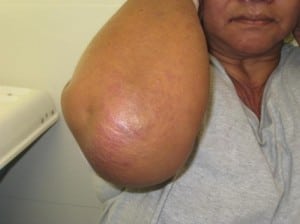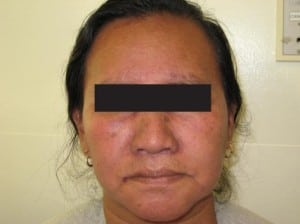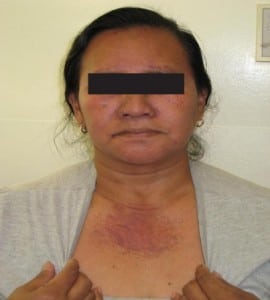| Author | Affiliation |
|---|---|
| Senai Kidane, MD | Alameda County Medical Center, Department of Emergency Medicine |
| Eric R. Snoey, MD | Alameda County Medical Center, Department of Emergency Medicine |
A 41-year-old Guatemalan woman with a history of remote uterine cancer presented to an urban community Emergency Department complaining of a pruritic, initially painful rash on her chest, eyelids, thighs, and elbows for three weeks. She also stated she had weakness in her thighs and shoulders with difficulty standing. She denied any new exposures (ex. foods, clothes, soaps, fragrances, medicines, or illicit drugs), recent travel, bites, or recent trauma. She denied fever, night sweats, weight loss, recent illnesses, or sick contacts. Her vital signs were normal and stable. On exam she was found to have circumferential, violaceous patches on her eyelids and proximal chest, and erythematous patches on the extensor surfaces of her elbows and in a malar distribution on her face. She was noted to have proximal thigh weakness and was unable to get up from a chair without assistance. The remainder of her exam, including sensation, cranial nerves, and distal motor function, was otherwise unremarkable. Laboratory studies were remarkable for an AST of 336, ALT of 158, LDH of 1948, CK of 9031, and ANA +. Her CBC and remaining metabolic panel were within normal limits. She was presumptively diagnosed with dermatomyositis and referred to general medicine and rheumatology clinics where she was started on a course of Prednisone with marked resolution of her symptoms. She recovered without sequelae.
Dermatomyositis (DM) is part of spectrum of idiopathic inflammatory myopathies. It has a prevalence rate estimated at approximately one per 100,000 in the general population with a 2:1 female predominance, and peak incidence between the ages of 40 and 50. Diagnosis is largely clinical and includes symmetric, proximal muscle weakness, characteristic rash, and elevated muscle enzymes. Common skin findings include Gottron’s sign (symmetric, roughened, erythematous skin changes over the extensor surfaces of the metacarpophalangeal and interphalangeal joints, elbows, or knees), heliotrope rash (a violaceous eruption on the upper eyelids sometimes accompanied by edema), and shawl sign (a diffuse flat erythema in a shawl-like distribution over the chest and shoulder, or a V-shaped pattern over the anterior neck and chest).
Both measurement of serum muscle enzyme levels (CK, LDH, aldolase, AST, ALT) and testing for the presence of myositis-specific autoantibodies play important diagnostic and prognostic roles in the assessment of patients with suspected DM. Other diagnostic and prognostic modalities include electromyography, MRI, and tissue biopsy. Prognosis is related to the severity of symptoms. Significant associated complications are not uncommon and can include interstitial lung disease and malignancy, and to a lesser extent esophageal disease and myocarditis. Therapy should be guided primarily by the degree of motor involvement and consists primarily of glucocorticoids and supportive therapy.

Gottron’s Sign

Hiliotrope Rash and Erythroderm

Shawl sign
Footnotes
Supervising Section Editor: Rick A. McPheeters, DO
Submission history: Submitted December 6, 2007; Revision Received February 4, 2008; Accepted February 4, 2008
Full text available through open access at http://escholarship.org/uc/uciem_westjem
Address for correspondence: Eric R. Snoey, MD, Department of Emergency Medicine, Alameda County Medical Center, 1411 East 31st Street, Oakland, CA 94602
Email: esnoey@acmedctr.org
Conflicts of Interest: By the WestJEM article submission agreement, all authors are required to disclose all affiliations, funding sources, and financial or management relationships that could be perceived as potential sources of bias. The authors disclosed none.
REFERENCES
1. Dalakas MC, Hohfeld R. Polymyositis and dermatomyositis. Lancet. 2003;362:971.[PubMed]
2. Kissel JT, Mendell JR, Rammohan KW. Microvascular deposition of complement membrane attack complex in dermatomyositis. N Engl J Med. 1986;314:329. [PubMed]
3. Targoff IN. Myositis specific autoantibodies. Curr Rhematol Rep. 2006;8:196.
4. Tymms KE, Webb J. Dermatopolymyositis and other connective autoantibodies play important diagnostic tissue diseases: A review of 105 cases. J Rhematol. 1985;12:1140.


